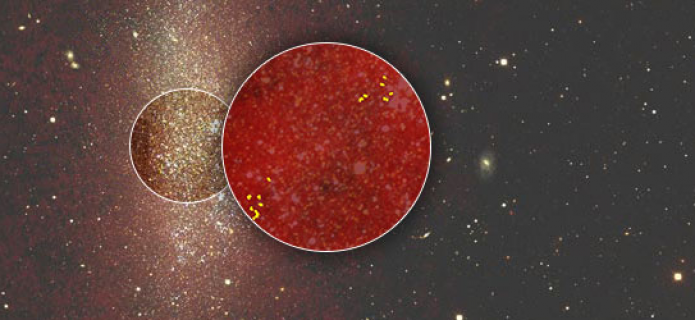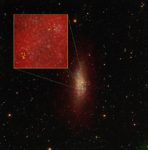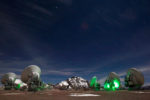ALMA Discover How Lowly Dwarf Galaxy Becomes Star-Forming Powerhouse
A nearby dwarf galaxy poses an intriguing mystery: How is it able to form brilliant star clusters without the dusty, gas-rich environments found in larger galaxies? The answer, astronomers believe, lies in densely packed and previously unrecognized nuggets of star-forming material sprinkled throughout the galaxy.
An international team of astronomers [1] using the Atacama Large Millimeter/submillimeter Array (ALMA) has discovered an unexpected population of compact interstellar clouds hidden within the nearby dwarf irregular galaxy [2] Wolf—Lundmark—Melotte, more commonly known as WLM.
These clouds, which are nestled within a heavy blanket of interstellar material, help explain how dense star clusters [3] are able to form in the tenuous environs of a galaxy thousands of times smaller and far more diffuse than our own Milky Way.
"For many reasons, dwarf irregular galaxies like WLM are poorly equipped to form star clusters," noted Monica Rubio, as astronomer with the University of Chile and lead author on a paper to appear in the scientific journal Nature. "These galaxies are fluffy with very low densities. They also lack the heavy elements that contribute to star formation. Such galaxies should only form dispersed stars rather than concentrated clusters, but that is clearly not the case."
By studying this galaxy with ALMA, the astronomers were able to locate, for the first time, compact regions that appear able to emulate the nurturing environments found in larger galaxies.
These regions were discovered by pinpointing the almost imperceptible and highly localized millimeter wavelength light emitted by carbon monoxide (CO) molecules, which are typically associated with star-forming interstellar clouds.
Earlier, an affiliated team of astronomers led by Deidre Hunter at the Lowell Observatory in Flagstaff, Ariz., first detected CO in the WLM galaxy with the single-dish Atacama Pathfinder Experiment (APEX) telescope [4]. These initial, low-resolution observations could not resolve where the molecules reside, but they did confirm that WLM contains the lowest abundance of CO ever detected in any galaxy. This lack of CO and other heavy elements should put a serious damper on star formation, the astronomers note.
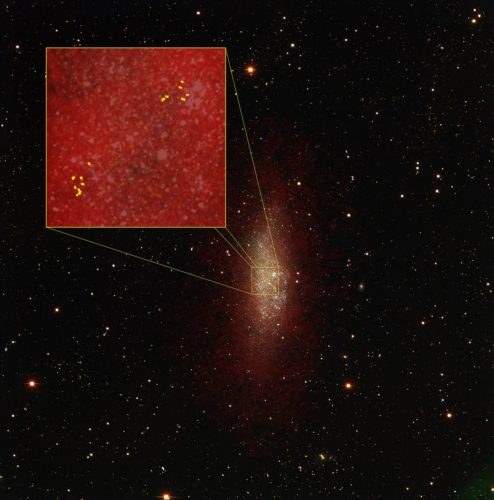
ALMA discovers an unexpected population of compact interstellar clouds inside the dwarf irregular galaxy WLM. These star-forming clouds provide the necessary nurturing environment to form star clusters. As seen in relation to an optical image of the galaxy taken with the Blanco 4-meter telescope (CTIO, Cerro Tololo, Chile), (box upper left) an overlaying blanket of hydrogen gas (red) imaged with NRAO's VLA telescope provides the pressure necessary to concentrate molecules of carbon monoxide (yellow) as seen with ALMA. These regions correspond to dense cores capable of forming clusters like those found in the Milky Way and other large galaxies. Credit: B. Saxton (NRAO/AUI/NSF); M. Rubio et al., Universidad de Chile, ALMA (NRAO/ESO/NAOJ); D. Hunter and A. Schruba, VLA (NRAO/AUI/NSF); P. Massey/Lowell Observatory and K. Olsen (NOAO/AURA/NSF)
"Molecules, and carbon monoxide in particular, play an important role in star formation," said Rubio. "As gas clouds begin to collapse, temperatures and densities rise, pushing back against gravity. That’s where these molecules and dust particles come to the rescue by absorbing some of the heat through collisions and radiating it into space at infrared and submillimeter wavelengths."This cooling effect enables gravity to continue the collapse until a star forms.
The problem previously was that in WLM and similar galaxies with very low abundances of heavy elements, astronomers simply didn’t see enough of this material to account for the new star clusters they observed.
The reason the CO was initially so difficult to see, the researchers discovered, is that unlike in normal galaxies, the WLM clouds are very tiny compared to their overlying envelopes of molecular and atomic gas.
To become viable star factories, the concentrated CO clouds need these enormous envelopes of transitional gas to bear down on them, giving the cores of CO a high enough density to allow them to form a normal cluster of stars.
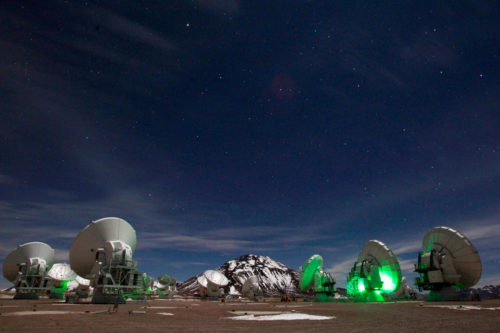
The ALMA telescope as seen at night. Its superior resolution and sensitivity allow it to detect and image the faint millimeter-wavelength light emitted by molecules in space. Credit: C. Padilla (NRAO/AUI/NSF)
"Like a diver being squeezed at the bottom of a deep abyss, these bundles of star-forming gas are under tremendous pressure, even though the surrounding ocean of interstellar gas is much more shallow," said Bruce Elmegreen, a co-author on the paper and researcher at the IBM T.J. Watson Research Center in Yorktown Heights, N.Y. "By discovering that the carbon monoxide is confined to highly concentrated regions within a vast expanse of transitional gas, we could finally understand the mechanisms that led to the impressive stellar neighborhoods we see in the galaxy today."
Further studies with ALMA will also help determine the conditions that formed the globular clusters found in the halo of the Milky Way. Astronomers believe these much larger clusters may have originally formed in dwarf galaxies and later migrated to the halo after their host dwarf galaxies dispersed.
WLM is a relatively isolated dwarf galaxy located approximately 3 million light-years away on the outer edges of the Local Group: the collection of galaxies that includes the Milky Way, the Magellanic Clouds, Andromeda, M33, and dozens of smaller galaxies.
The optical image of the galaxy was taken with the Blanco 4-meter telescope. ALMA data reveal the presence of dense clouds of star-forming dust and gas. The zoom-in illustrates how a collection of stars would appear within one such cloud. Credit: Animation by B. Saxton (NRAO/AUI/NSF); Optical data: P. Massey/Lowell Observatory and K. Olsen (NOAO/AURA/NSF); ALMA data: M. Rubio et al., Universidad de Chile, ALMA (NRAO/ESO/NAOJ): Fly-in animation by B. Kent (NRAO/AUI/NSF)
Artist animation revealing an emerging star cluster in the WLM galaxy. The optical image of the galaxy was taken with the Blanco 4-meter telescope and ALMA data reveal the presence of dense clouds of star-forming dust and gas. The zoom-in illustrates how a collection of stars would appear within one such cloud. Credit: Animation by B. Saxton (NRAO/AUI/NSF); Optical data: P. Massey/Lowell Observatory and K. Olsen (NOAO/AURA/NSF); ALMA data: M. Rubio et al., Universidad de Chile, ALMA (NRAO/ESO/NAOJ)
The Atacama Large Millimeter/submillimeter Array (ALMA), an international astronomy facility, is a partnership of the European Organisation for Astronomical Research in the Southern Hemisphere (ESO), the U.S. National Science Foundation (NSF) and the National Institutes of Natural Sciences (NINS) of Japan in cooperation with the Republic of Chile. ALMA is funded by ESO on behalf of its Member States, by NSF in cooperation with the National Research Council of Canada (NRC) and the Ministry of Science and Technology (MOST) in Taiwan and by NINS in cooperation with the Academia Sinica (AS) in Taiwan and the Korea Astronomy and Space Science Institute (KASI).
ALMA construction and operations are led by ESO on behalf of its Member States; by the National Radio Astronomy Observatory (NRAO), managed by Associated Universities, Inc. (AUI), on behalf of North America; and by the National Astronomical Observatory of Japan (NAOJ) on behalf of East Asia. The Joint ALMA Observatory (JAO) provides the unified leadership and management of the construction, commissioning and operation of ALMA.
Notes
[1] Collaborators in the present study include Monica Rubio, Universidad de Chile, Santiago; Bruce G. Elmegreen, IBM T.J. Watson Research Center, Yorktown Heights, N.Y.; Deidre A. Hunter, Lowell Observatory, Flagstaff, Ariz; Elias Brinks, University of Hertfordshire, UK; Juan R. Cortes, Joint ALMA Observatory and National Radio Astronomy Observatory, Santiago, Chile; and Phil Cigan, New Mexico Institute of Mining and Technology, Socorro.
[2] Irregular galaxies lack the distinctive shapes of spiral and elliptical galaxies. Dwarf irregulars, like WLM, are hundreds of times smaller than the larger variety and contain only a few hundred million stars instead of tens of billions. Though small, some are now known to harbor massive black holes at their centers.
[3] Star clusters, like the Pleiades found in our own Milky Way galaxy, are made up of hundreds of stars. Others, like globular clusters, can contain hundreds of thousands to a few million stars. Though many stars in Milky Way originally form in clusters, some – like the Sun – drift away from their stellar nurseries and move freely throughout their home galaxy. Stars in the largest and densest clusters, like those observed in WLM, remain relatively close together.
[4] The APEX team was led by Deidre Hunter at the Lowell Observatory in Flagstaff, Ariz., and Elias Brinks at the University of Hertfordshire, U.K. It also included Monica Rubio; Bruce Elmegreen; Andreas Schruba, California Institute of Technology, Pasadena, Calif.; and Celia Verdugo, University of Chile.
Contacts
Valeria Foncea
Education and Public Outreach Officer
Joint ALMA Observatory
Santiago, Chile
Tel: +56 2 467 6258
Cell: +56 9 75871963
Email: [email protected]
Charles E. Blue
Public Information Officer
National Radio Astronomy Observatory
Charlottesville, Virginia, USA
Tel: +1 434 296 0314
Cell: +1 434.242.9559
E-mail: [email protected]
Richard Hook
Public Information Officer, ESO
Garching bei München, Germany
Tel: +49 89 3200 6655
Cell: +49 151 1537 3591
Email: [email protected]
Masaaki Hiramatsu
Education and Public Outreach Officer, NAOJ Chile
Observatory, Tokyo, Japan
Tel: +81 422 34 3630
E-mail: [email protected]
